People are always asking me what the funny letters and abbreviations on the dog’s pedigrees mean. This list is by no means complete – and I will try to make it easy to understand for members of the public – All you breeders out there know what it all means anyway!! For a complete set of all the correct rules and regulations, refer to the KUSA website.
V – V Rating
This is a highly sought after show ring grading which a specialist Rottweiler judge may award a dog.
The V Rating is not a working title.
A dog of under 18 months may be awarded a V rating – but only a V rating which is awarded after the dog is over 18 months will appear on his or her pedigree. In order for a dog to be declared a champion, he or she must have achieved two V ratings under specialist judges – amongst other achievements too.
Please note that a dog that is a champion is not “THE CHAMPION” – there are lots of champion dogs at any time – they achieved all the requirements in the show ring.
BA – BREED ASSESSMENT
This is the Breed Assessment. The BA is usually only done once or twice a year – only by suitably qualified specialist overseas judges.
Passing the BA is a requirement for Championship Status for a dog.
The BA is not a working title.
The BA reports for Dexster and Bunny and Roxy are available for your scrutiny on their pages – just so that you can see what it looks like. The dog is weighed and measured – height at the withers, circumference of the chest, length – the eye colour is graded with the help of a nifty little box which has coloured marbles in – if the marble colour matches the eye colour, then that is the grading the dog will get – eye colour is very important and the darker the colour the more desirable.
All the physical traits of the dog should conform to the SA Breed Standard for Rottweilers – this is available for you to see on the KUSA website.
The dog is also tested for temperament with various excercises where the dog is crowded, tested for reaction to a gunshot, his reaction to a train station type of situation etc. Dogs that are skittish and nervous and display fear or aggression will be disqualifed or deferred. The general idea is that a dog may only be presented once in its lifetime for a BA – if it fails then that is it. In some cases, dogs may be deferred for six months or so and be allowed to be presented again.
Dogs that do not have a BA may still be bred in South Africa.
As with so many things lately though, I have to say that the standards in South Africa are slipping and lately there have been dogs awarded the qualification that were less than deserving – and this is not only my opinion – it has been the subject of much debate – the problem is that dogs that have earned the qualification fairly and squarely are now slightly compromised – I am hoping that the integrity of the BA will be restored in the future and once again be judged 100% according to German rules.
BST – Breed Suitability Test.
The BST is basically a BA with some manwork added to it.
The BST is not a working title.
The dog will be required to perform part of the basic manwork routine which forms part of the IPO1 routine.
There are very few dogs in SA that have a BST qualification – Bond and Maverick being included in that rather prestigous group. Orka achieved his ADRK BST in Germany where there were three specialist judges present – they don’t play the fool there you know!!
Oliver’s mother, Gaia, who belongs to Lulu Maree of Liberlumar Rottweilers in Cape Town is one of the few bitches in South Africa with a BST qualification.
BWT – now called IPOVO
The BWT is a working title which allows the dog to be entered in the working class of a Specialist Rottweiler Show. It has since been removed as a title – the equivalent now being called IPOVO, but the qualification does not allow the dog to be entered in the Working Class of the Specialist Rottweiler shows. Maverick is the proud owner of a BWT and as such is usually shown in the Working Class in the Showring at Specialist Shows.
IPO1 – Internasionale Prufsordong
That long word basically means that the dog is an Internationally Qualified Protection Dog.
The IPO is a working title!
Strictly speaking, only dogs that have this title should be called “working rottweilers.” It is very confusing for people who go to an All Breed Show to be confronted with the “working group” and to find a Rottweiler in that group – many people automatically then assume that those dogs have working titles – this is not true at all – just unfortunate wording coming into play I am afraid!
At a Specialist Rottweiler Show, only dogs that have the correct paperwork required may be entered in the working class. For many years there were no entries in the working class at the Specialist Rottweiler shows – Bond, Gaelic,Indio and Maverick changed all that.
Orka was trained in Germany up to IPO3 and all his certificates and qualifications are available for you to see on his profile.
It is true that many breeders speak at length with the public who enquire about puppies about the dog’s working ability – or the puppy’s “drive” – this is not correct – anybody can get a puppy to play with a ball and then call it working drive! Many people claim to “work” their dogs – and this may be so, but this does not mean that the dog has any qualification to his name and that he or she should be presented to the public as any kind of a working dog. Maybe you could say it is a bit like saying – Well I am a Doctor because I went to Medschool but I never wrote the final exam…
Only a dog that has been tested for IPO by a suitably qualified judge, and who has passed the test – can lay any claim to being a working dog.
However, any Rottweiler should have enough “working ability” to pass a working title – should he or she have an owner willing to put in the work and the effort and the money required to obtain it!
IPO1 is the first of the IPO titles – followed of course by IPO2 and IPO3. This is the ultimate title for any dog to achieve and trumps any showing title that may be achieved (in my opinion of course!)
The IPO is not a beauty competition but an exceptionally difficult discipline which can take years to achieve.
The IPO consists of tracking, obedience and manwork.
The IPO becomes a part of the dog’s pedigree – so basically you can say that a dog has a University Degree if he has an IPO1 – a Masters Degree if he has an IPO2 and he is a “Doctor Professor” if he has an IPO3!
In very loose terms, the IPO dog has to be able to do all the things that a trained police dog can do – however, the dog has to perform the tasks on a competition level for IPO – whereas the Police Dog is more result driven. The usual order of business at an IPO Trial is Tracking first thing in the morning, followed by Obedience in the afternoon and Manwork as the final event.
Rotek is the working club that we are affiliated too – John Swartz is ROTEK – a very dear friend and certainly one of the best dog handlers in South Africa – he also arranges the Meisterschaft every year – this is a very big IPO competion, usually dominated by German Shepherd dogs and Malinois. The fact that Rottweilers are not very well represented is not the Rottweiler’s fault – there are a couple of people lately who are once again taking their training quite seriously, so hopefully they will get there one day and we will once again have qualified working dogs in SA.
Pictured below are the working dogs of South Africa as they were then – Bond, Gaelic and Indio. I think that it is fair to say that these dogs got the working thing going again in South Africa. The IPO dog is always going to be the most special dog – no other title or prize can ever come close to the magic of the qualified working dog!
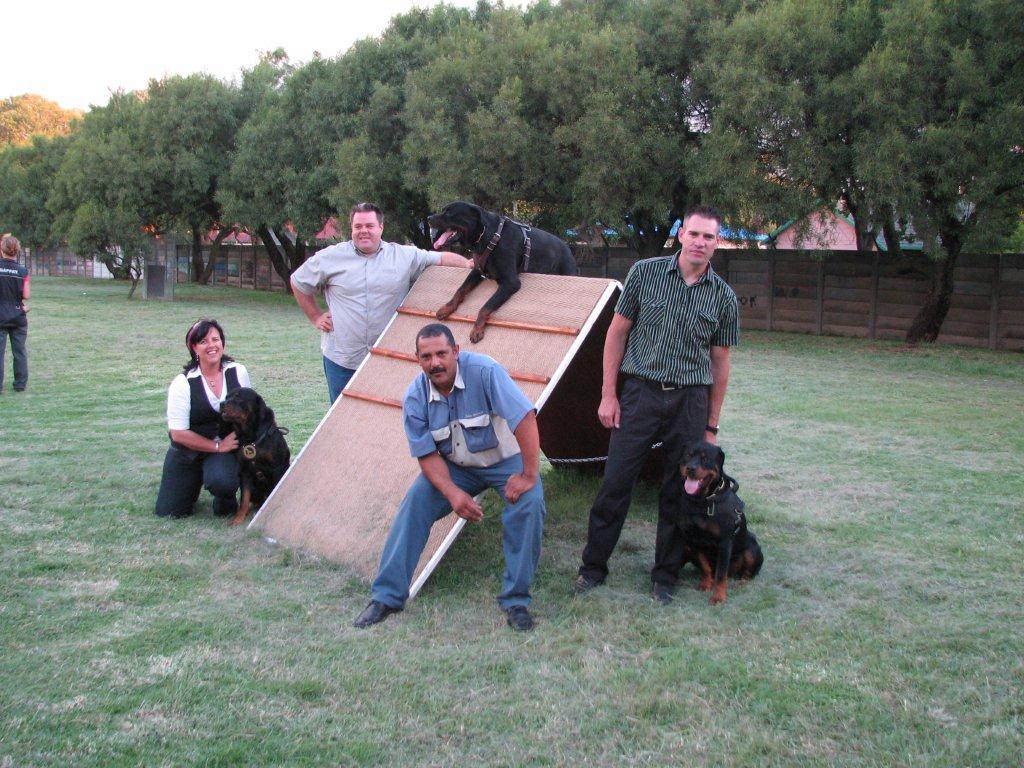
Bond was the trained in Germany by World Champion IPO helper and handler Oliver Neubrand, and we were very priveledged to have had Oliver come to South Africa for a seminar on working. I am including a few photos of Bond and Oliver and I doing some of the exercises and will add one or two explanations of what is happening – please note that once again this is by no means a complete picture of IPO – this is only the tip of the iceberg!
When Bond arrived in South Africa he had the basic training to compete in IPO almost ready – Marius Vorster qualified him for IPO1 on the same day that he qualified his own dog and also on the first day that he ever entered an IPO trial. Does this count as one of the best days of my life? DEFINITELY!! To have owned and loved an amazing dog like Bond is an honour and a priveledge and was worth every cent and every hour and every drop of petrol and sponsorship and advertising and eventual heartbreak!
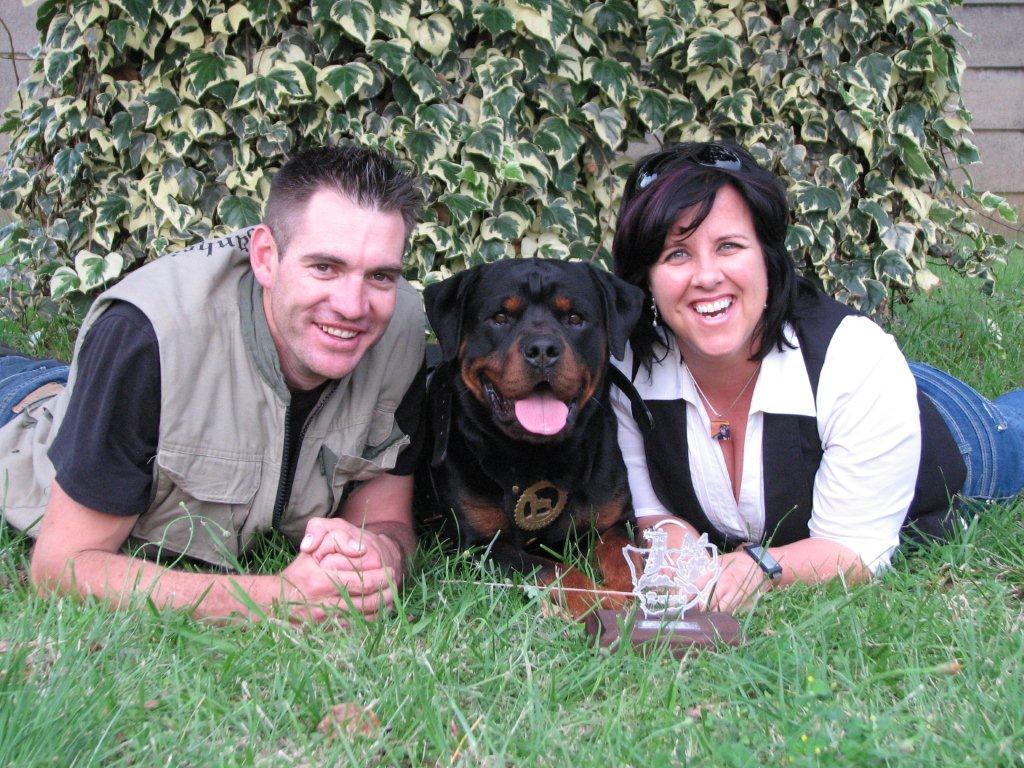
Tracking: So, to put it simply, for tracking, the police dog has to find the person or the article – in whatever manner works for him. The IPO dog has to follow a certain procedure and stick to countless rules and regulations – among others, he has to track with his nose on the ground as opposed to air scenting – and he has to indicate that he has found the article on a laid track – he is not allowed to pick it up or try to pull it to pieces – he also has to keep his body in a perfectly straight line on the track once he has found the article. All tracks have a couple of corners, depending on which title you are competing in – the dog has to stay on the track and may not cut the corner. Where does the track come from? The track is laid by the handler for IPO1, so the dog follows his owner’s scent. For IPO2 and 3 the track is laid by a stranger and is also required to age for a period before the dog begins.
Below are some photos of the seminar that we had with Oliver Neubrand – tracking with Bond – in the trial the handler will be at the end of the 10m rope – see how Bond’s nose is in the ground!
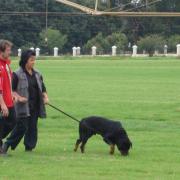
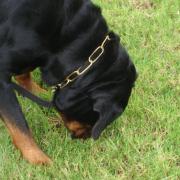
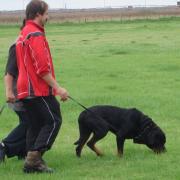
Obedience: The obedience routine for IPO is a set pattern and the dog and handler are scored according to very strict rules. Very difficult – don’t let them fool you!! Watching a dog and a handler that are good at Obedience is indeed like watching poetry unfold – hours and hours and hours of work and dedication goes into every aspect of IPO, but in my mind the Obedience is the most difficult. Obedience exercises include the walking pattern where the dog is required to stick to his owner’s side and follow on commands to sit, platz and stand – walk at different paces and do about turns – this must all be done quickly and smartly and the focus of the dog must be on the handler at all times. The dog also has to scale an A frame to retrieve a dumbbell, as well as jump over a jump of a certain height – once again to retrieve a dumb bell – which should then presented in the correct manner – no way to get into exactly all the rules and regulations – suffice it to say that there is lots that can go wrong!
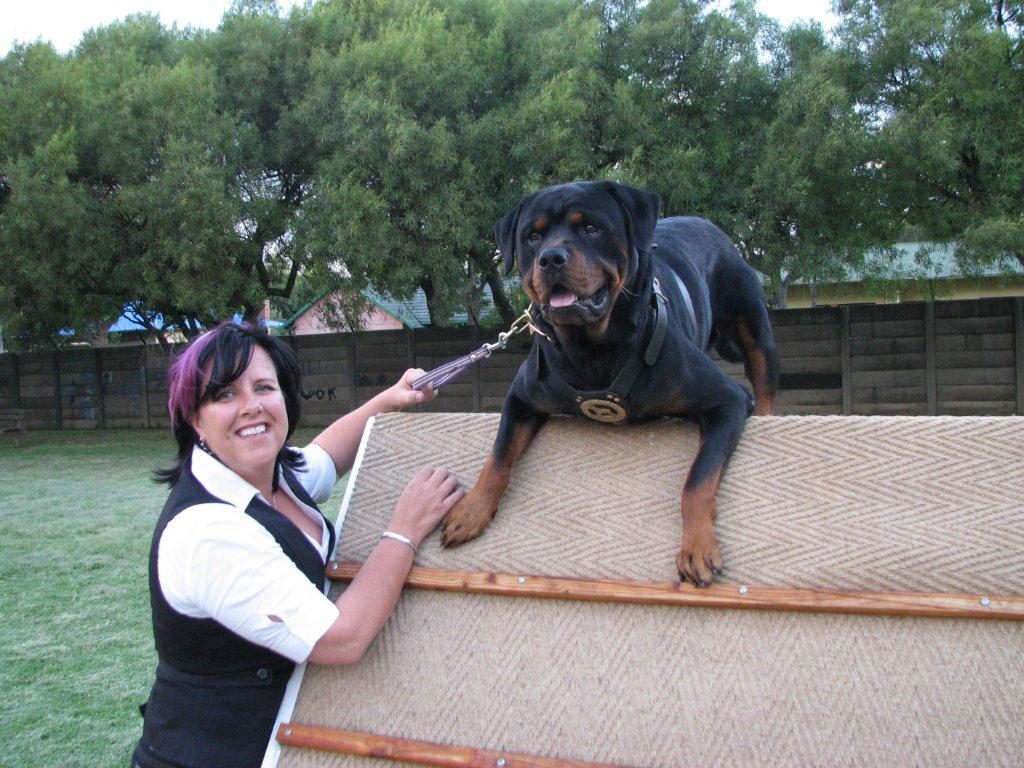
Manwork: Also known as Protection work. Here for instance, police dog has to attack the culprit and hold on for dear life – this is of course a live bite and culprit is going to get bitten good and proper. In the IPO competition, the dog has to bite an artificial arm sleeve which is presented to him – he has to bite it in a certain place and with a full bite and he will be lifted off the ground and swung around – and after that he has to leave the sleeve immediately on being told to do so – the correct term is AUSS – which means leave in German. Should the dog not “Auss” then he is immediately disqualified from the trial. The dog may obviously also not bite the helper anywhere besides in the correct place on the presented sleeve. The dog will also be given two stick blows by the helper (the guy with the sleeve) – and dogs that come off the sleeve as a result of a stick blow are also disqualified.
ROTEK 21 MARCH 2009 BOND AND MAVERICK 027.jpg IT TOOK A WHILE FOR ME NOT TO BE INTIMIDATED BY A SNARLING DOG – BUT THE MINUTE I TOUCH HIM HE REACTS WAITS FOR THE NEXT COMMAND – HE LOVES WORKING!!.jpg ROTEK 21 MARCH 2009 BOND AND MAVERICK 026.jpg LEAVING THE HELPER IMMEDIATELY ON THE AUSS COMMAND.jpg JOHN JUST LOVES BOND AND THE WAY HE BITES – AND THAT HE JUST DOESN’T CONSIDER LETTING GO!! (1).jpg ROTEK 21 MARCH 2009 BOND AND MAVERICK 025.jpg JOHN JUST LOVES BOND AND THE WAY HE BITES – AND THAT HE JUST DOESN’T CONSIDER LETTING GO!!.jpg ROTEK 21 MARCH 2009 BOND AND MAVERICK 023.jpg OLIVER NEUBRAND SEMINAR APRIL 2010 096.jpg OLIVER NEUBRAND SEMINAR APRIL 2010 095.jpg HOLD IT, HOLD IT, HOLD IT, – BOND GOT A GOOD SMACK WHEN HE GRABBED THE SLEEVE WITHOUT PERMISSION – BUT HE DIDN’T DO IT AGAIN!!.jpg OLIVER NEUBRAND SEMINAR APRIL 2010 089.jpg HOLD AND BARK – THE DOG HOLDS THE ASSAILANT IN THE HIDE – HE MAY NOT BITE – HE BARKS AND SHOULD NOT BACK DOWN AT ALL – HE MAY ONLY BITE WHEN TOLD TO.. (10).jpg
When the helper is in the hide – as you can see with Oliver and Bond pictured above – this is called a “Hold and Bark” – basically the helper is cornered by the dog who is required to bark at him without biting him – the idea is that he has caught the bad guy and he is waiting for backup from his handler. Later on the helper runs away, and the dog is then required to chase him and catch him on the sleeve.
The object of manwork is complete control of the dog – he may only bite when told to do so and it has nothing to do with aggression – he just happens to have a lot of big teeth in his mouth and most dogs love biting the sleeve – to them it is a reward for a job well done and they see it as playing a game with the handlers and helpers. Believe me, manwork requires a lot more than the dog biting the sleeve – he has to run hides and has to have excellent obedience skills or he won’t be able to make the grade. Of all three disciplines, manwork is the one that attracts the most attention at the trials – it is exciting and the dogs also love it.
After Bond was qualified in IPO1, yours truly entered an IPO Trial at Rotek with him – I trained for six months – please note I was the one needing the training – not Bond, who by the way is considered to be the best working Rottweiler we have had in South Africa.
Anyway, I never made the grade – but I only missed it by a few points I must add – it was as close as dammit! So it is definitely a team effort – dog, handler and trainer – and all three have to be good – I am not a dog handler and the first to admit it. I suppose you could liken it to saying that, just because you like to go to the Ballet, it doesn’t mean that you want to be a Ballerina. In my case, it turned out that having Michael Schumacher’s car in my garage still didn’t make it possible for me to win the race!!
But be that as it may, I am still one of the very few people who have actually entered an IPO Trial with a Rottweiler in South Africa – and believe me, being on the field is a whole lot different to sitting in the stands offering lots of criticism – which all of us dog breeders seem to be very good at!!
BREED RESTRICTIONS!!
On the top right hand corner of your Registration is a little thing called NOTATION/S AS PER BREEDER – underneath it will say either NONE or it will say PROGENY NOT ELIGIBLE FOR REGISTRATION. This is a tricky business for members of the Public wanting to buy a puppy that they might want to have a litter with – most people presume that if the puppy is KUSA registered, then it has papers – right?
WRONG!!
The dog may only be bred if there are no notations as per breeder – this is very NB – and a lot of breeders are very much aware of the perception that people have about the “papers” and will sell the puppy to wannabe breeders – with restrictions – which means that it may not be bred – so why have a KUSA REGISTERED dog then in the first place??
If you are wanting to buy a puppy which may be bred later on in its life – which is your full right – MAKE SURE THAT THE PAPERS HAVE NO RESTRICTIONS NOTED – FULL STOP!!
Countless beautiful dogs out there that can’t be bred because the breeder has left the country – or is in jail – or just plain refuses to remove the restriction because he is “protecting his bloodline”. I would go so far as to say that, as a puppy buyer who might want to have a litter, no money should change hands until the papers without restrictions are presented by the breeder! Of course this does not apply to all breeders, but please watch out for this – I get so many phone calls from people asking how they can lift the breed restriction on their dog – the plain truth is that only the breeder can remove it – nobody else.
Another great trick is to charge unsuspecting members of the public extra for selling them a puppy without a breed restriction – of course this is not illegal – but to my mind not at all fair play – the puppy could still fail hips and elbows etc etc – and please be assured that there will be nobody around to refund the buyer the extra cash should that be the case!
Breed restrictions may be placed on a puppy that has a disqualifying fault – for instance a huge white patch on the chest – or an overbite – or other physical defects – obviously those are puppies that should not be bred with, and in my opinion this is what the breed restriction option is for.
Having said all that, it is not at all my opinion that all dogs should be bred – everything but! It is my preference for people to have their animals sterilized to prevent any unwanted litters which all just add to the rescue situation. However, it is all people’s right to breed their dog, and in this instance I feel that the best route to take is to try to ensure that any puppies that are bred will be registered at KUSA – the only way to do this is to assist people as far as possible and make the relevant information available to them. A breed restriction on a piece of paper is not a sterilization – it does not stop puppies from being born – it only ensures unregistered puppies when unscrupolous breeders refuse to lift it.



